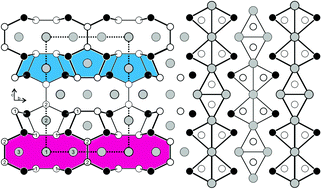Abstract
The silicide Sc5Pd4Si6 was synthesized from the elements by arc-melting. Its structure was refined from single crystal X-ray diffractometer data: Immm, Li5Cu3.75P6 type, a = 397.12(6), b = 945.4(1), c = 1314.4(2) pm, wR2 = 0.0245, 578 F2 values and 29 parameters. The palladium atoms have slightly distorted tetrahedral silicon coordination and a condensation of these PdSi4 tetrahedra leads to a two-dimensional substructure which is condensed via Si2 pairs (234 pm Si–Si), forming the [Pd4Si6]δ− polyanionic network. The Sc5Pd4Si6 structure contains three crystallographically independent scandium sites with coordinations Sc1@Pd4Si8Sc6, Sc2@Pd6Si6Sc3 and Sc3@Pd4Si6Sc4. Sc5Pd4Si6 is a Pauli paramagnet with a low susceptibility of 2.9(5) × 10−5 emu mol−1 at room temperature. The 29Si MAS-NMR spectrum confirms the presence of two crystallographically distinct sites in a 2 : 1 ratio. Likewise, the three crystallographic scandium sites are well-differentiated by three 45Sc MAS NMR signals in the expected 2 : 2 : 1 ratio. Unambiguous assignments could be made based on the comparison of the nuclear electric quadrupolar coupling parameters with predicted values from WIEN2k calculations.



 Please wait while we load your content...
Please wait while we load your content...